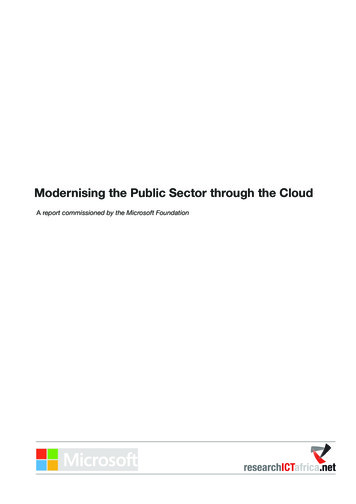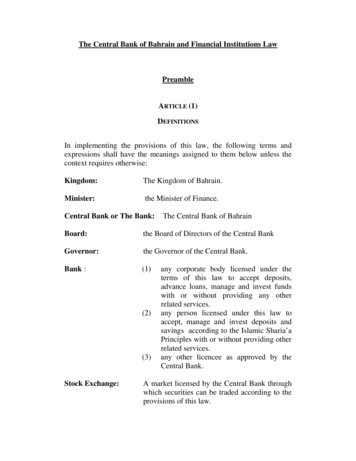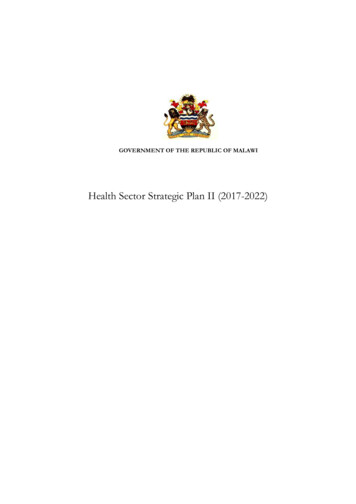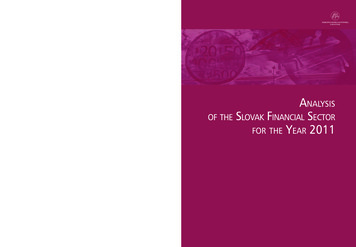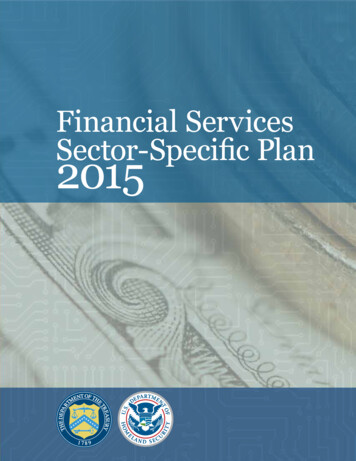
Transcription
Financial ServicesSector-Specific Plan2015
This page intentionally left blank.
Financial ServicesSector-Specific Plan2015Financial and Banking Information Infrastructure CommitteeFBIIC
Financial Services Sector-Specific Plan 2015This page intentionally left blank.iv
Financial Services Sector-Specific Plan 2015Table of ContentsIntroductory Comments.1Executive Summary. 3Introduction. 5Sector Overview . 6Sector Profile . 6Deposit, Consumer Credit, and Payment Systems Products . 6Credit and Liquidity Products.7Investment Products.7Risk Transfer Products (Including Insurance) .7Sector Risks . 8Critical Infrastructure Partners.10Financial Services Sector Coordinating Council for Critical Infrastructure Protection andHomeland Security Structure . 11Financial and Banking Information Infrastructure Committee Structure . 11Collaboration .12Strategic Framework .13Achieving Sector Goals .15Information Sharing.15Best Practices.16Incident Response and Recovery .17Policy Support .17Measuring Effectiveness .18Appendix A: Contribution of Sector Priorities to the Joint National Priorities and NIPP Goals.19v
Financial Services Sector-Specific Plan 2015This page intentionally left blank.vi
Introductory CommentsWe are pleased to present the 2015 Financial Services Sector-Specific Plan (SSP) which providesan overview of the sector and the cybersecurity and physical risks it faces, establishes a strategicframework that serves as a guide for prioritizing the sector’s day-to-day work, and describes the keymechanisms through which this strategic framework is implemented and assessed. This plan wasdeveloped through close collaboration among the U.S. Department of the Treasury (Treasury), theFinancial Services Sector Coordinating Council for Critical Infrastructure Protection and HomelandSecurity (FSSCC), the Financial and Banking Information Infrastructure Committee (FBIIC), andthe U.S. Department of Homeland Security. Collectively, this plan reflects the efforts of hundreds ofpublic and private sector stakeholders representing all aspects of the sector.The organizations that make up the Financial Services Sector form the backbone of the Nation’sfinancial system and are a vital component of the global economy. These organizations are tiedtogether through a network of electronic systems with innumerable entry points. An incident,whether manmade or natural, impacting these systems could have detrimental effects on theentire economy. Our SSP provides a shared strategy for reducing the risk associated with suchan event. As an element of the 2013 National Infrastructure Protection Plan (NIPP) framework,this plan enables integration of the Financial Services Sector’s security and resilience effortswith the broader national framework of critical infrastructure protection activities.This SSP responds to the evolving risk environment, especially the increasing importanceof cybersecurity to the sector, and reflects progress made on building a collaborative publicprivate partnership since the release of the 2010 SSP. Examples of Financial Services Sectoraccomplishments since publication of the 2010 SSP include: Creating a public-private cybersecurity exercise program to test and improve incidentresponse processes; Significantly expanding the sector’s cybersecurity information sharing capabilities, includingthrough the rapid growth of the Financial Services Information Sharing and Analysis Center (FSISAC) and the establishment of Treasury’s Financial Sector Cyber Intelligence Group (CIG); Establishing a formalized structure of joint working groups to advance specific tasks; Formalizing processes for coordinating technical assistance activities; and Expanding collaboration with cross-sector and international partners.The Financial Services Sector private and public sector coordinating councils – the FSSCCand FBIIC respectively – are pleased to support this SSP and look forward to sustaining andenhancing the security and resilience of critical infrastructure in the sector.Amias GeretyActing Assistant Secretary, Financial InstitutionsU.S. Department of the TreasuryChair, Financial and Banking Information Infrastructure CommitteeRuss FitzgibbonsChair, Financial Services SectorCoordinating CouncilCaitlin DurkovichAssistant Secretary, Infrastructure ProtectionU.S. Department of Homeland SecurityJohn CarlsonVice Chair, Financial Services SectorCoordinating Council
Financial Services Sector-Specific Plan 2015This page intentionally left blank.2
Financial Services Sector-Specific Plan 2015Executive SummaryThe security and resilience of the Financial Services Sector depends on close collaborationamong a broad set of partners, including Financial Services Sector companies; sector tradeassociations; Federal government agencies; financial regulators; State, local, tribal, andterritorial governments; and other government and private sector partners in the U.S. andaround the world. These partners seek to reduce the physical and cybersecurity risks that takemany forms but, particularly in the case of cybersecurity threats, are becoming increasinglypressing.Responding to a broad set of risks in a complex environment requires a shared and flexiblestrategic framework to inform decision-making among individual stakeholders, each of whommaintains their own distinct approach to risk management. The 2015 SSP provides an overviewof the sector and the risk it faces, establishes a strategic framework that serves as a guide forprioritizing the sector’s day-to-day work, and describes the key mechanisms through which thestrategic framework is implemented and assessed.The Financial Services Sector pursues a shared security and reliance mission:Continuously enhance security and resilience within the FinancialServices Sector through a strong community of private companies,government agencies, and international partners that establishes sharedawareness of threats and vulnerabilities, continuously enhances baselinesecurity levels, and coordinates rapid response to and recovery fromsignificant incidents as they occur.Executing this mission and working to achieve the sector’s goals and priorities advances ashared security and resilience vision:A secure and stable financial system operating environment that maintainsconfidence in the integrity of global financial transactions, assets, and data.In order to improve its security and resilience and advance its vision and mission, the sectorworks to advance four primary goals:1.Implement and maintain structured routines for sharing timely and actionable informationrelated to cybersecurity and physical threats and vulnerabilities among firms, across sectorsof industry, and between the private sector and government.2. Improve risk management capabilities and the security posture of firms across the FinancialServices Sector and the service providers they rely on by encouraging the development anduse of common approaches and best practices.3. Collaborate with the homeland security, law enforcement, and intelligence communities;financial regulatory authorities; other sectors of industry; and international partners torespond to and recover from significant incidents.3
Financial Services Sector-Specific Plan 20154. Discuss policy and regulatory initiatives that advance infrastructure security and resiliencepriorities through robust coordination between government and industry.Each goal is, in turn, accomplished through work done on a set of shared sector prioritiesthat help to guide day-to-day work in a manner consistent with the NIPP’s goals and the jointnational priorities, and in support of a whole-of-nation effort to improve security and resilienceacross sectors.4
Financial Services Sector-Specific Plan 2015IntroductionThe Financial Services Sector faces a complex and evolving risk environment that has thepotential to disrupt the sector’s ability to deliver services that are critical to the nation’seconomy. To manage this risk, a diverse set of stakeholders—including Financial Services Sectorcompanies; sector trade associations; Federal government agencies; financial regulators; State,local, tribal, and territorial governments; and other government and private sector partnersin the United States and around the world—collaborate to enhance the sector’s security andresilience.The 2015 SSP provides an overview of the sector and the risk it faces, establishes a strategicframework that serves as a guide for prioritizing the sector’s day-to-day work, and describes thekey mechanisms through which the strategic framework is implemented and assessed. To ensureconsistency with other national security and resilience efforts, the SSP aligns to the priorities setforth in the 2013 NIPP and the joint national priorities, which provide a common national focalpoint for partnership efforts across sectors, as demonstrated in Appendix A.The SSP is a product of the ongoing collaboration on Financial Services Sector security andresilience issues among public and private sector partners, who have a long history of identifyingand achieving shared goals and priorities to reduce risk. This SSP also responds to the evolvingrisk environment, especially the increasing importance of cybersecurity to the sector, andreflects progress made on building a collaborative public-private partnership since the release ofthe 2010 SSP.5
Financial Services Sector-Specific Plan 2015Sector OverviewThe Financial Services Sector is highly diverse. Each financial institution has unique securityand resilience needs, resources, and plans depending on the functions it performs and itsapproach to risk management.Effectively reducing the sector’s physical and cybersecurity risk requires a shared understandingof the critical services the sector provides, the specific security and resilience risks it faces, andthe collaboration mechanisms used among the sector’s security and resilience stakeholders.Sector ProfileThe Financial Services Sector includes thousands of depository institutions, providers ofinvestment products, insurance companies, other credit and financing organizations, and theproviders of the critical financial utilities and services that support these functions. Financialinstitutions vary widely in size and presence, ranging from some of the world’s largest globalcompanies with thousands of employees and many billions of dollars in assets, to communitybanks and credit unions with a small number of employees serving individual communities.Financial institutions are organized and regulated based on the services the institutions provide.Therefore, the profile of the sector is best described by defining the services offered. Thesecategories include: (1) deposit, consumer credit, and payment systems products; (2) credit andliquidity products; (3) investment products; and (4) risk transfer products.Deposit, Consumer Credit, and Payment Systems ProductsDepository institutions of all types are the primary providers of wholesale and retail paymentsservices, such as wire transfers, checking accounts, and credit and debit cards. Depositoryinstitutions and their technology service providers facilitate the conduct of transactions acrossthe payments infrastructure, including electronic large value transfer systems, automatedclearinghouses (ACH), and automated teller machines (ATM). These institutions are theprimary point of contact with the sector for many individual customers.In addition, depository institutions provide customers with various forms of extensions ofcredit, such as mortgages and home equity loans, collateralized and uncollateralized loans, andlines of credit, including credit cards. Consumers have multiple ways of accessing these services.For example, customers can make deposits in person at a depository institution’s branch office,over the Internet, at an ATM, through the mail, via direct deposit using ACH transactions, viaremote deposit capture, or on mobile devices.These institutions may be National or State-chartered banks or credit unions. At the Federallevel, primary regulatory responsibility for depository institutions is carried out by the Boardof Governors of the Federal Reserve System (FRB), the Federal Deposit Insurance Corporation(FDIC), the National Credit Union Administration (NCUA), and the Office of the Comptrollerof the Currency (OCC). In addition, the Consumer Financial Protection Bureau (CFPB) hasresponsibility for consumer protection laws. These regulators, along with the State LiaisonCommittee, develop uniform principles, guidances, and forms through the Federal Financial6
Financial Services Sector-Specific Plan 2015Institution Examination Council (FFIEC). In addition, State agencies regulate institutions thatare State-chartered according to their authorities.Credit and Liquidity ProductsCustomers seek liquidity and credit for a wide variety of needs. For example, individuals mayseek a mortgage to purchase a home, businesses may obtain a line of credit to expand theiroperations, and governments may issue sovereign debt obligations to fund operations or managemonetary and economic policy. Many financial institutions, such as depository institutions,finance and lending firms, securities firms, and government sponsored enterprises (GSEs) meetcustomers’ long- and short-term needs through a variety of financial products. Some of theseentities provide credit directly to the end customer, while others do so indirectly by providingliquidity to those financial services firms that provide these services on a retail basis.Essential to the credit and liquidity markets is the assurance that these products are availablewith integrity, fairness, and efficiency. The law provides consumer protections, including againstfraud involving these products. Furthermore, credit and liquidity products are governed by acomplex body of laws. These laws include Federal and State securities laws, banking laws, andlaws that are tailored to the specifics of a particular class of lending activity.Investment ProductsDiversity of investment service providers and products promotes the global competitivenessof U.S. financial markets. These products provide opportunities for both short- and long-terminvestments and include debt securities (such as bonds and bond mutual funds), equities (suchas stocks or stock mutual funds), exchange-traded funds, and derivatives (such as options andfutures). Securities firms, depository institutions, pension funds, and GSEs all offer financialproducts that are used for investing needs. These investment products are issued and traded invarious organized markets, from physical trading floors to electronic markets. The Securitiesand Exchange Commission (SEC), the Commodity Futures Trading Commission (CFTC),banking regulators, and insurance regulators all provide financial regulation for certaininvestment products, along with self-regulatory organizations.Risk Transfer Products (Including Insurance)The transfer of financial risks, such as the financial loss due to theft or the destruction ofphysical or electronic property resulting from a fire, cybersecurity incident, or other lossevent, or the loss of income due to a death or disability in a family, is an important tool forthe sustainability of businesses and economic vitality of individuals and their families. A widevariety of financial institutions provide risk transfer products to meet this market need.The U.S. market for financial risk transfer products is among the largest in the world, measuringin the trillions of dollars. These products range from being noncomplex to highly complex. Forexample, insurance companies, futures firms, and forward market participants offer financialproducts that allow customers to transfer various types of financial risks under a myriad ofcircumstances. Market participants often engage in both financial investments as well as infinancial risk transfers that enable risk hedging. Financial derivatives, including futures andsecurity derivatives, can provide both of these functions for market participants.7
Financial Services Sector-Specific Plan 2015Sector RisksFinancial institutions face an evolving and dynamic set of risks, including operational, liquidity,credit, legal, and reputational risk. The SSP focuses specifically on a subset of operational riskfactors against which capital cannot be held that include managing the possibility of a physicalor cybersecurity incident that jeopardizes critical systems.Collectively, these organizations form the backbone of the Nation’s financial system and are avital component of the global economy. These organizations are tied together through a networkof electronic systems with innumerable entry points. An incident, whether manmade or natural,impacting these systems could have detrimental impacts throughout the economy.Most of the sector’s key services are provided through or conducted on information andcommunications technology platforms, making cybersecurity especially important to the sector.Malicious cyber actors continue to target the Financial Services Sector. These actors varyconsiderably in terms of motivation and capability, but all cybersecurity incidents, regardless ofthe original motive, have the potential to disrupt critical systems, even inadvertently.In addition, the sector faces ongoing risks associated with natural disasters, as well as thepotential for physical attacks. Hurricanes, tornadoes, floods, and terrorist attacks all have thepotential to cause physical disruptions that have significant impacts on Financial Services Sectoroperations. The attacks of September 11, 2001, caused the securities markets and several futuresexchanges to close until communications and other services were transferred to alternatesites or restored to lower Manhattan. Beginning in the summer of 2012, financial institutions, including smaller institutions,experienced a series of coordinated distributed denial-of-service (DDoS) attacks againsttheir public-facing websites. These incidents affected customer access to bankinginformation, but did not impact core systems or processes. On October 29, 2012, the landfall of Superstorm Sandy caused a two-day closure of majorequities exchanges, while fixed income markets were closed for one day. In recent years, cybercriminals have accessed numerous retailer and other networks to stealcredit card information and other financial data.To reduce the risk associated with incidents like these, the Financial Services Sectorcontinuously assesses its risk posture by understanding its vulnerabilities and the current threatlandscape and adjusting its approach to security and resilience based on these assessments. Riskassessments are a long-standing and accepted practice within the Financial Services Sector andare widely conducted by individual institutions and expected by regulators.To aid in assessing the risk to the sector overall, U.S. Department of the Treasury (Treasury),financial regulators, the U.S. Department of Homeland Security (DHS), law enforcement andother government partners regularly coordinate with financial institutions to share information8
Financial Services Sector-Specific Plan 2015about current and emerging threats, develop mitigation strategies, and determine whether anyexisting or new assets or processes may be critical to the operations of the sector and, thus,require special attention. This coordination occurs primarily through the exchange of incidentdata, through the collaborative development of threat and mitigation information products, andregularly scheduled and event-driven meetings, as well as through regulatory processes.Essential to understanding the sector’s cybersecurity and physical risks is the identification ofcritical processes and their dependence on information technology and supporting operationsfor the delivery of financial products and services. As the sector integrates new informationand communications technologies to meet market demand for more efficiency and innovativeservices, new risks may emerge. Given that financial institutions and technology serviceproviders are tightly interconnected in a dynamic marketplace, an incident impacting one firmhas the potential to have cascading impacts that quickly affect other firms or sectors. This riskis exacerbated by the fact that financial institutions depend on other sectors for key services likeelectricity, communications, and transportation.In order to manage risk most effectively, many institutions work to identify infrastructure andprocesses that are most sensitive and take extra precautions to protect that infrastructure. Atthe same time, identifying the institutions that perform critical operational roles for the sector iskey to assuring their rapid recovery from a disruption of their critical functions, regardless of thecause. Identifying key infrastructure, processes, and institutions is also necessary for developingappropriate business continuity planning and recovery protocols as well as continually testingand refining those protocols.As appropriate, financial institutions, executive branch agencies, financial regulators, andothers work together to document critical systems, infrastructure, and institutions anduse that information to inform security and resilience programs. For example, Section 9 ofExecutive Order (EO) 13636 requires that DHS identify critical infrastructure against which acybersecurity incident could result in catastrophic regional or national effects on public healthor safety, economic security, or national security. The primary purpose of this process is tobetter understand national and regional cyber dependencies and consequences across criticalinfrastructure, inform planning and program development for Federal critical infrastructuresecurity and resilience programs, and motivate identified critical infrastructure owners andoperators to maintain robust cyber risk management programs.Under the EO 13636 Section 9 framework, owners and operators of identified criticalinfrastructure whose business and operations depend on an extensive network of informationand communications technology and software (or “cyber dependent”) may be eligible forexpedited processing of clearance through the DHS Private Sector Clearance Program, whichmay provide access to classified government cybersecurity threat information as appropriate.Cyber-dependent critical infrastructure may also be prioritized for routine and incident-drivencyber technical assistance activities offered by DHS and other agencies. As Federal governmentresources and programs develop and improve to enhance the security and resilience of criticalinfrastructure against cybersecurity threats, cyber-dependent critical infrastructure will be acontinued priority.9
Financial Services Sector-Specific Plan 2015Critical Infrastructure PartnersIn response to the cybersecurity and physical risks faced by the sector, a network of FinancialServices Sector companies; sector trade associations; Federal government agencies; financialregulators; State, local, tribal, and territorial governments; and other government and privatesector partners in the U.S. and around the world collaborate on multiple levels to enable thesector’s security and resilience. These partnerships are at times formal and at other times moreinformal.The Financial Services Sector’s umbrella organizations for critical infrastructure protection arethe private-sector-led Financial Services Sector Coordinating Council for Critical InfrastructureProtection and Homeland Security (FSSCC) and the government-led Financial and BankingInformation Infrastructure Committee (FBIIC). The FSSCC and FBIIC respectively serve as theSector Coordinating Council and Government Coordinating Council for the Financial ServicesSector. The FBIIC and FSSCC collaborate closely, including through triannual joint meetings,based on the structure established in Presidential Policy Directive 21 (2014) and the NIPP.The Financial Services Sector critical infrastructure partnership includes a variety ofstakeholders in addition to the FSSCC and FBIIC: Private Sector: FSSCC, Financial Services Information Sharing and Analysis Center (FSISAC), individual firms, trade associations, regional coalitions, security service providers,technology service providers, and industry partners from other sectors; Executive Branch: Treasury, DHS (including the United States Secret Service), U.S.Department of Justice (including the Federal Bureau of Investigation), U.S. Department ofDefense, and other departments and agencies; Financial Regulators: FBIIC agencies,1 which includes banking and credit union regulators;securities regulators; self-regulatory organizations; and State regulators; State, Local, Tribal, and Territorial Partners; and International: Non-U.S. based financial institutions and service providers, non-U.S.regulators, and non-U.S. law enforcement, intelligence community, and homeland securitygovernment partners.It is important to emphasize that financial institutions provide services under the supervisionof a well-established regulatory framework. The U.S. financial regulatory system includes bothFederal and State regulatory agencies and, in some cases, self-regulatory organizations. Amongtheir responsibilities, regulatory agencies are concerned with institutional and systemic ability1American Council of State Savings Supervisors, Commodity Futures Trading Commission, Conference of State Bank Supervisors,Consumer Financial Protection Bureau, Department of the Treasury, Farm Credit Administration, Federal Deposit InsuranceCorporation, Federal Housing Finance Agency, Federal Reserve Bank of Chicago, Federal Reserve Bank of New York, Boardof Governors of the Federal Reserve System, National Association of Insurance Commissioners, National Association of StateCredit Union Supervisors, National Credit Union Administration, North American Securities Administrators Association, Officeof the Comptroller of the Currency, Securities and Exchange Commission, and Securities Investor Protection Corporation10
Financial Services Sector-Specific Plan 2015to withstand operational disruptions and strive to promote confidence in the Financial ServicesSector.Financial Services Sector Coordinating Council for Critical InfrastructureProtection and Homeland Security StructureThe FSSCC serves as the Sector Coordinating Council for the Financial Services Sector. Asof December 2015, the FSSCC membership involves 24 sector associations and 46 financialinstitutions representing major subsectors of the industry. Specifically, trade groups, such asthe American Bankers Association, the Financial Services Roundtable, The Clearing House,the Securities Industry and Financial Markets Association, NACHA, Independent CommunityBankers of America, and the Bank Administration Institute, participate actively in the FSSCCand play a strong role in supporting collaborative efforts among their members and with othergroups. Furthermore, regional coalitions like ChicagoFIRST play a critical role in coordinatingsecurity and resilience efforts among financial institutions spread throughout the nation.The FSSCC and its member organizations promote security and resilience of the sectorthrough information sharing, incident response, and recovery efforts, and by promoting bestpractices and the development of effective policies. In addition, the FS-ISAC, which servesas the operational arm of the FSSCC, shares specific information pertaining to cybersecurityand physical risks and distributes recommendations for protective measures and practices tothousands of institutions across the sector.Financial and Banking Information Infrastructure Committee StructureThe FBIIC serves as the Government Coordinati
Financial Services Sector-Speciic Plan 2015 3 . Executive Summary . The security and resilience of the Financial Services Sector depends on close collaboration among a broad set of partners, including Financial Services Sector companies; sector trade associations; Federal government agencies; inancial regulators; State, local, tribal, and





